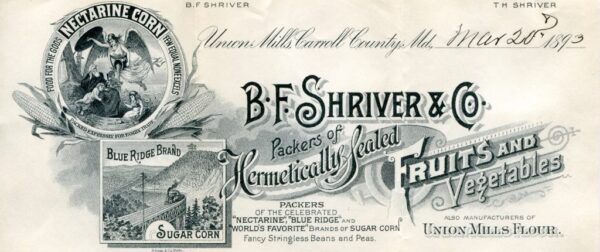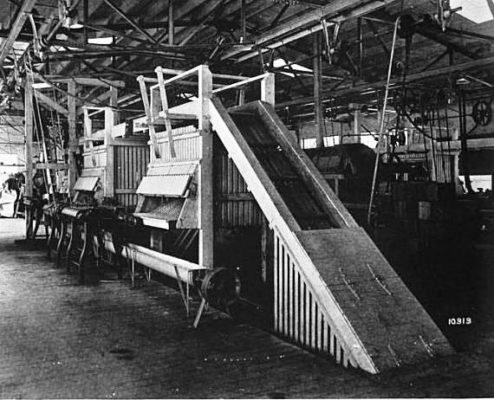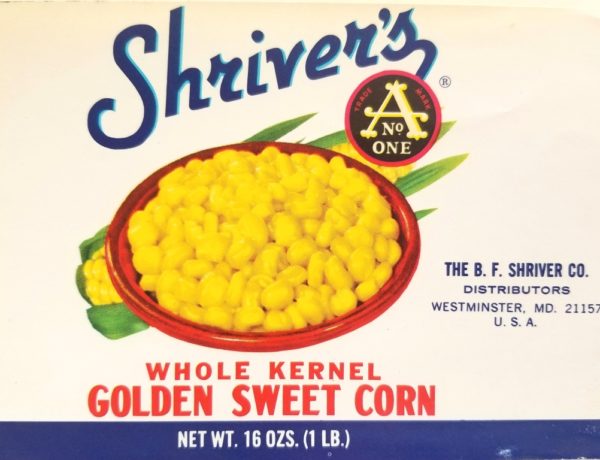B.F. Shriver Co. 150th Anniversary Event
In 1869, Benjamin Franklin Shriver (known to friends and family as “Frank”) started a cannery to preserve excess crops from his father’s farming and milling business. He set up a small canning operation in the cooper’s shop adjacent to the grist mill at Union Mills, owned by his father William Shriver. From this modest shop, where B.F. Shriver began packing corn and cherries, grew one of Maryland’s largest canning businesses. By the time the firm was sold in the 1970s, it owned thousands of acres of farmland, had been in business for over a century, and left of a legacy of technological innovation. An event on Saturday, October 26 will commemorate this proud heritage. The program, to be held at the Baltimore Museum of Industry, starts at 11 a.m.
A Family Tradition
B.F. Shriver’s entry into the canning business was inspired by a family history steeped in agricultural-related industry. Shriver’s grandfather Andrew Shriver founded Union Mills in 1797 with his brother David Shriver, Jr., in a joint enterprise that featured the latest technology of its time – an automated mill. By 1869, the grist mill was owned by Andrew’s son, William. Attached to the mill was the small cooper’s shop, where barrels were made to ship flour to market.

Elaborate Letterhead of the B.F. Shriver Co. in the 1890s reflects its involvement in a variety of food processing industries.
A few years after B.F. Shriver started his canning business, he moved his cannery from the cooper’s shop to the other side of the Littlestown Pike. In 1874, B.F. Shriver brought his brother, T. Herbert Shriver, into the business as a partner as part of the company’s rapid growth. In 1881 the company expanded to a plant on Liberty Street in Westminster.
Leaders in Technological Innovations

A 1919 image of the B.F. Shriver Co. factory on Railroad Avenue in Westminster.
Around 1900, the B.F. Shriver Co. moved its Westminster operations to a new location along Railroad Avenue. In 1919, the company built a new factory at the Railroad Avenue site. This new facility was built using the most modern conveyors for the processing of canned goods. The Westminster factory was one of six plants owned by the company, which provided a total capacity of over a million cases a year by the time of B.F. Shriver’s death in 1921. Adoption of the latest in technological advances helped spur the firm’s success.

A corn conveyor in the B.F. Shriver Co.’s Westminster factory in the 1920s
Many of these technological innovations are on display at the Baltimore Museum of Industry’s canning exhibit. Among the displays: a retort, or pressure cooker, which was invented by B.F. Shriver’s brother. This invention increased the efficiency of food production and played a key part of the B.F. Shriver Co.’s growth. These innovations also brought tremendous benefits to human nutrition. Please join us on October 26 to learn more about this fascinating history and to celebrate this big anniversary!
B.F. Shriver Co. Anniversary Program:
Place: Baltimore Museum of Industry (http://www.thebmi.org/)
Address: 1415 Key Highway, Baltimore, MD 21230
Date: Saturday,October 26, 2019
Time: 11 a.m.
Cost: Program included in price of admission ($12 for adults)


Granddaughter of Sara Shriver Schneider’s. Would love to be there but have other plans this weekend. Celebrate
So proud of my family heritage and glad my family is continuing to contribute with innovation and inventions.
I sure do remember those special cans . Only peas I would eat . Celebrating our sons wedding in Florida that weekend. Blessings to all that can attend .
My father, John Oliver Blizzard, Jr., was born to Margaret Ferree Shriver Blizzard, in an old farmhouse just up the Old Hanover Road from the Mills. My parents were staying at the same farmhouse when my mother went into labor with me, and they rushed to Annie Warner Hospital in Gettysburg, where I was born on January 16, 1955 — making me the only Yankee in our immediate family! Coincidentally, my younger brother and sister were also born at the site of a Civil War battle, in Chattanooga, TN. Mama’s ancestry traces to the Potomac River valley (south branch) in western Virginia, also a site of Civil War conflict, where her great grandfather, a local preacher, was murdered by a naricissistic Union officer who claimed he was a spy for the Confederacy.
I’ve toured the Homestead house and gristmill, but it was at least a half-century ago, and I’d love to see the old place again. I vividly remember the enormous fireplace in the kitchen, big enough to stand in, and have compared similar fireplaces in other homes of that era, which all seem smaller, despite the eminence of the men who built and owned those homes. Truly, the Shriver Homestead is an outstanding and memorable place in our nation’s history!